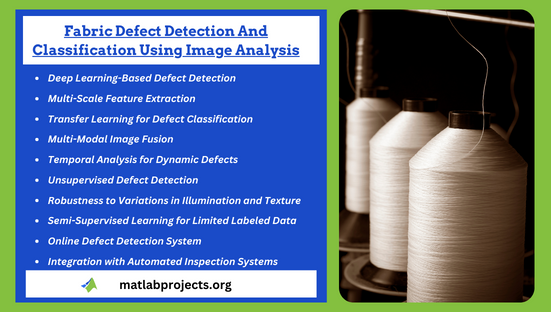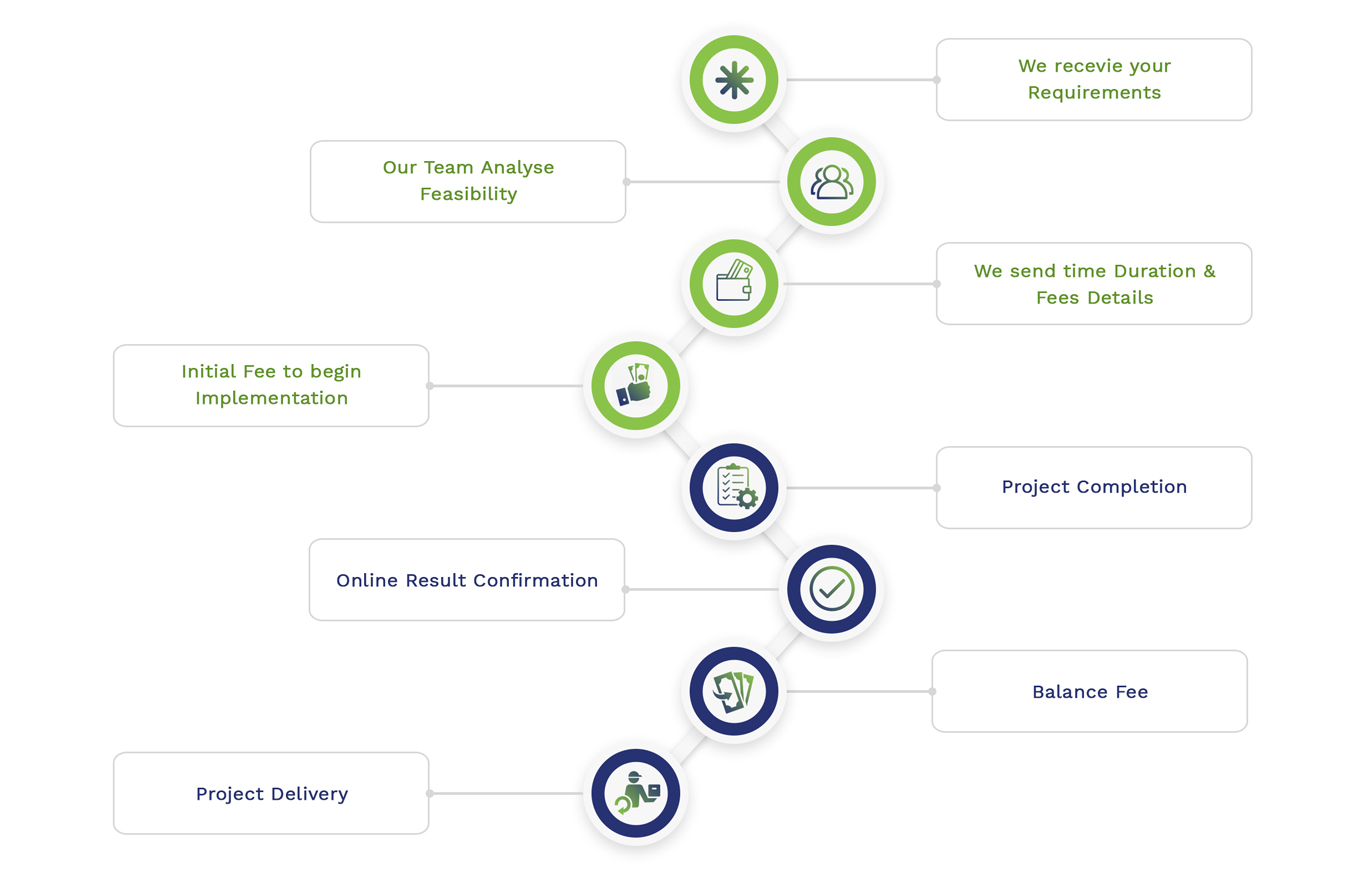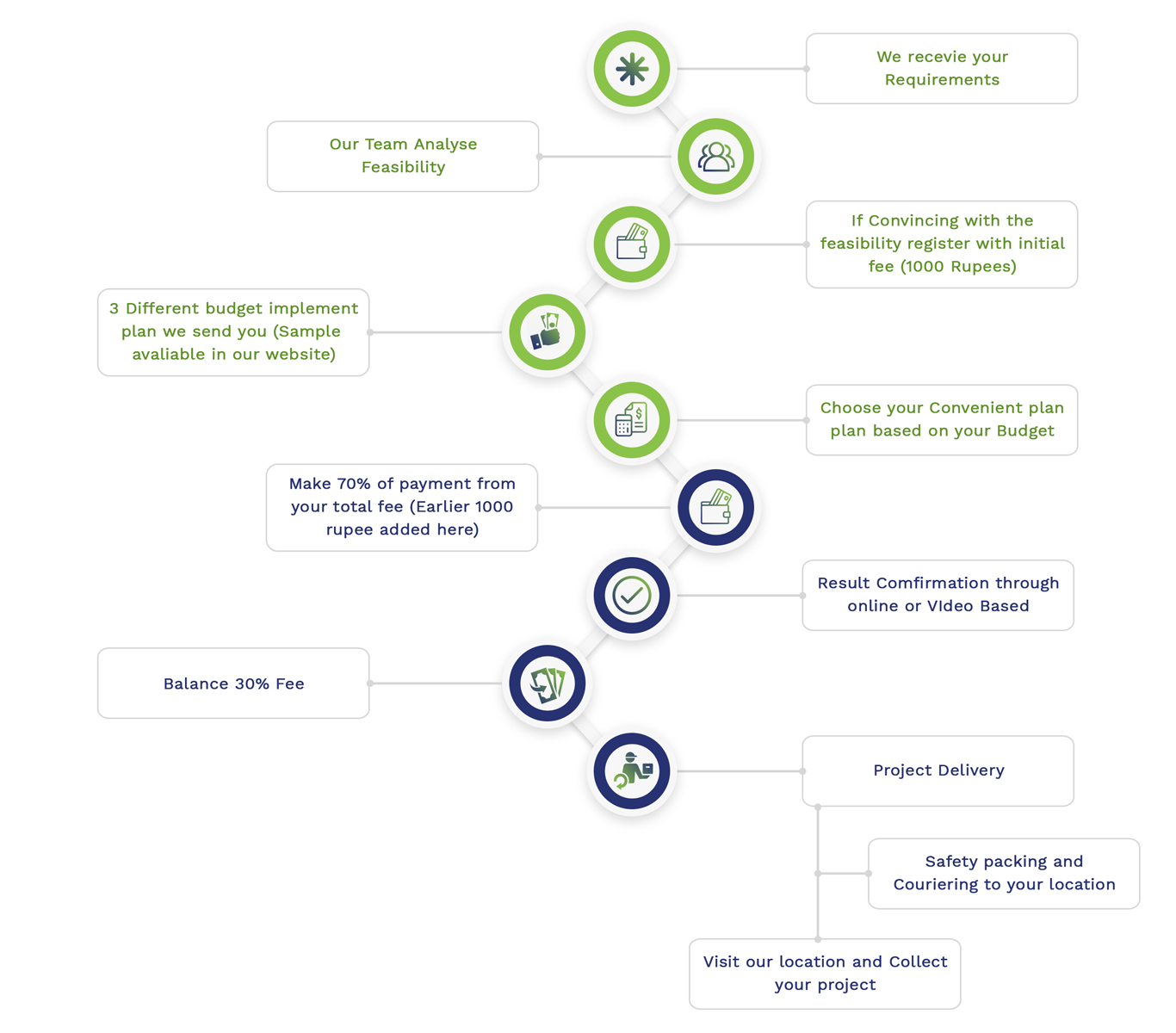There are several research ideas that are progressing in the field of fabric defect detection. At matlabprojects.org, we are the top team dedicated to helping with Fabric Defect Detection research. We provide a well-defined and captivating topic with a clear focus, along with thorough research questions and objectives. Receive invaluable assistance throughout your research journey. The following are few research plans in this discipline:
- Deep Learning-Based Defect Detection:
- Specifically, for fabric defect detection, research the utilization of deep learning approaches like convolutional neural networks (CNNs). It is approachable to investigate infrastructures designed for identifying defects of different sizes, consistencies, and shapes, and aim to assess their effectiveness on various kinds of fabric.
- Multi-Scale Feature Extraction:
- For multi-scale feature extraction, construct appropriate methods in order to seize regional as well as universal features of fabric defects. For enhanced defect identification precision, focus on integrating characteristics at various ranges through the utilization of approaches such as multi-resolution analysis or pyramid depiction.
- Transfer Learning for Defect Classification:
- To utilize pre-trained systems for fabric defect categorization, investigate transfer learning techniques. To categorize fabric defects, fine-tune deep learning systems are trained on extensive image datasets, thereby altering them to the certain features of textile images.
- Multi-Modal Image Fusion:
- In order to improve defect visibility and diverseness in fabric images, focus on researching multimodal image fusion approaches. Typically, to enhance defect detection and categorization effectiveness, it is appreciable to integrate visual information from various imaging types like visible light, infrared, or ultraviolet.
- Temporal Analysis for Dynamic Defects:
- For temporal analysis of video series, construct efficient techniques to identify and monitor dynamic defects in actual-time. To manage dynamic defects which might exist or progress periodically at the time of textile production procedures, aim to expand fabric defect detection algorithms.
- Unsupervised Defect Detection:
- For fabric defect identification which does not need labelled training data, investigate unsupervised learning techniques. On the basis of anomaly identification or clustering approaches, create suitable methods in order to recognize anomalous areas in fabric images reflective of defects.
- Robustness to Variations in Illumination and Texture:
- Effective to various differences in texture, lighting, surface patterns that are normally faced in textile images, model defect identification methods. To improve method effectiveness under differing situations, it is appreciable to integrate approaches for normalization, augmentation, and adaptive thresholding.
- Semi-Supervised Learning for Limited Labeled Data:
- By means of examining semi-supervised learning approaches, aim to solve the limitation of constrained labelled data for fabric detect categorization. Typically, to enhance categorization effectiveness when reducing the requirement for manual explanation, construct efficient methods that utilize labelled as well as unlabelled data.
- Online Defect Detection System:
- For actual-time quality control, it is advisable to model an online fabric defect detection framework that is incorporated into textile production procedures. To facilitate beneficial identification and interference at the time of manufacturing, create methods enhanced for performance and less-delay processing.
- Integration with Automated Inspection Systems:
- For continuous incorporation into business production platforms, focus on combining fabric defect detection methods along with automated inspection models and robotics environments. Specifically, for interaction and cooperation among image analysis models and robotic inspection devices, it is better to build interfaces and protocols.
Fabric defect detection and classification algorithms and Dataset for Research
Together with datasets, we provide few usual fabric defect detection and categorization methods that are employed for study in this research domain:
Fabric Defect Detection and Classification Algorithms:
- Convolutional Neural Networks (CNNs):
- For fabric defect detection and categorization, CNNs are extensively utilized because of their capability to learn differential characteristics from image data. Mainly, for this mission, infrastructures like U-Net, VGG, and ResNet can be designed and trained appropriately.
- Support Vector Machines (SVM):
- For binary categorization missions such as defect vs. non-defect categorization, SVMs are employed, which is considered as conventional machine learning methods. For splitting various categories of defects on the basis of handcrafted characteristics that are obtained from fabric images, they are very efficient and suitable.
- Gaussian Mixture Models (GMMs):
- Typically, for clustering and intensity assessment, GMMs are probabilistic systems that are utilized. By identifying differences as possible defects and designing the dissemination of pixel densities in defect-free areas, this model can be implemented to fabric defect identification.
- Local Binary Patterns (LBP):
- LBP is determined as a texture descriptor. For seizing regional trends in images, it is employed. By encoding texture details and identifying abnormalities or variations from usual trends, it can be used for feature extraction in fabric defect detection.
- Thresholding and Morphological Operations:
- For segmenting defects from fabric images on the basis of density or color variations, basic thresholding approaches and after that morphological functions such as erosion and dilation can be utilized. For basic defect detection missions, these approaches are examined as efficient and valuable.
- Deep Learning-Based Object Detection:
- By considering defects as key elements in images, object detection models like YOLO, SSD, and Faster R-CNN can be designed for fabric defect detection. Usually, these methods have the capability to identify and categorize defects at the same time.
- Adaptive Filtering and Edge Detection:
- To improve defect limits and obtain related characteristics for categorization, edge detection algorithms like Canny edge detector and adaptive filtering approaches such as the adaptive median filter can be utilized.
Fabric Defect Detection and Classification Datasets:
- Fabric Defect Detection Benchmark Dataset (FDDB):
- Encompassing images of different fabric defects such as holes, stains, inconsistencies, and tears, the FDDB dataset is determined as an extensive benchmark dataset. For training and assessing defect identification methods, it offers defined ground truth labels.
- MVTec Anomaly Detection Dataset:
- Typically, images of different textured surfaces encompassing fabrics with defined ground truth abnormalities are covered in the MVTec AD dataset. For assessing anomaly identification methods, such as fabric defect detection algorithms, it is very appropriate.
- TEXFETEX Dataset:
- For training and examining fabric defect detection methods, the TEXFETEX dataset offers labelled images. Along with different kinds of defects like yarn defects, printing defects, and weaving defects, this dataset encompasses images of textile fabrics.
- GAUSS Dataset:
- In textile printing applications, GAUSS dataset is appropriate for assessing defect detection and categorization methods. Typically, this dataset includes images of printed textile fabrics together with defects such as color differences, texture inconsistencies, and printing defects.
- NEU Surface Defect Database:
- Images based on six kinds of surface defects are encompassed in the NEU dataset. It also involves fabric defects that are seized under differing lighting situations and viewing angles. For benchmarking defect identification methods, this dataset offers labelled images.
- FABRI Dataset:
- The images of fabric samples with different kinds of defects such as strains, holes, and color differences, are included in the FABRI dataset. For training and examining fabric defect detection and categorization methods, it is examined as appropriate.

Fabric Defect Detection and Classification Using Image Analysis Research Topics
Looking for research assistance on Fabric Defect Detection and Classification Using Image Analysis? At matlabprojects.org, we offer the best PhD Thesis Topics Research Help at an affordable cost. Our expert panel team is here to guide you through the process. Discover the hottest research topics in Fabric Defect Detection and Classification Using Image Analysis that are making waves in today’s world. Explore them below!
- YOLO-GFD: A Fast and Accurate Fabric Defect Detection Model
- A Fabric Defect Detection Algorithm Based on YOLOv8
- Unsupervised UNet for Fabric Defect Detection
- Weighted Double-Low-Rank Decomposition With Application to Fabric Defect Detection
- Fast Detection of Fabric Defects based on Neural Networks
- Patterned Fabric Defect Detection Based on Double-branch Parallel Improved Faster-RCNN
- An Analysis of Fabric Defect Detection Techniques for Textile Industry Quality Control
- A Fabric Defect Detection Method Based on Improved YOLOv5
- A Real-time Unsupervised Two-stage Framework for Fabric Defect Detection
- Hyperspectral Imaging Based Nonwoven Fabric Defect Detection Method Using LL-YOLOv5
- Fabric Defect Detection Method Based on Projection Location and Superpixel Segmentation
- An Improved DCGAN for Fabric Defect Detection
- Research on CNN Algorithm for Monochromatic Fabric Defect Detection
- YOLOv4-DCN-based fabric defect detection algorithm
- Detection of Fabric Defects Using Convolutional Networks
- A lightweight algorithm for woven fabric defect detection
- Efficient Fabric Defect Detection Algorithm Based on Improved YOLOv5
- Artificial Intelligence based Optimization with Extreme Gradient Boosting for Fabric Defect Detection and Classification Model
- Pixel-Wise Semisupervised Fabric Defect Detection Method Combined With Multitask Mean Teacher
- Parallel attention network based fabric defect detection
Subscribe Our Youtube Channel
You can Watch all Subjects Matlab & Simulink latest Innovative Project Results
Our services
We want to support Uncompromise Matlab service for all your Requirements Our Reseachers and Technical team keep update the technology for all subjects ,We assure We Meet out Your Needs.
Our Services
- Matlab Research Paper Help
- Matlab assignment help
- Matlab Project Help
- Matlab Homework Help
- Simulink assignment help
- Simulink Project Help
- Simulink Homework Help
- Matlab Research Paper Help
- NS3 Research Paper Help
- Omnet++ Research Paper Help
Our Benefits
- Customised Matlab Assignments
- Global Assignment Knowledge
- Best Assignment Writers
- Certified Matlab Trainers
- Experienced Matlab Developers
- Over 400k+ Satisfied Students
- Ontime support
- Best Price Guarantee
- Plagiarism Free Work
- Correct Citations
Expert Matlab services just 1-click

Delivery Materials
Unlimited support we offer you
For better understanding purpose we provide following Materials for all Kind of Research & Assignment & Homework service.
 Programs
Programs Designs
Designs Simulations
Simulations Results
Results Graphs
Graphs Result snapshot
Result snapshot Video Tutorial
Video Tutorial Instructions Profile
Instructions Profile  Sofware Install Guide
Sofware Install Guide Execution Guidance
Execution Guidance  Explanations
Explanations Implement Plan
Implement Plan
Matlab Projects
Matlab projects innovators has laid our steps in all dimension related to math works.Our concern support matlab projects for more than 10 years.Many Research scholars are benefited by our matlab projects service.We are trusted institution who supplies matlab projects for many universities and colleges.
Reasons to choose Matlab Projects .org???
Our Service are widely utilized by Research centers.More than 5000+ Projects & Thesis has been provided by us to Students & Research Scholars. All current mathworks software versions are being updated by us.
Our concern has provided the required solution for all the above mention technical problems required by clients with best Customer Support.
- Novel Idea
- Ontime Delivery
- Best Prices
- Unique Work
Simulation Projects Workflow

Embedded Projects Workflow



 Matlab
Matlab Simulink
Simulink NS3
NS3 OMNET++
OMNET++ COOJA
COOJA CONTIKI OS
CONTIKI OS NS2
NS2






